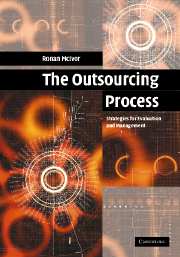Book contents
- Frontmatter
- Contents
- List of figures
- List of tables
- List of illustrations
- Acknowledgements
- 1 Introduction
- 2 The trend towards outsourcing
- 3 Theoretical influences on outsourcing
- 4 The outsourcing process: a framework for evaluation and management
- 5 Determining the current boundary of the organisation
- 6 Activity importance analysis
- 7 Capability analysis
- 8 An analysis of the strategic sourcing options
- 9 Developing the relationship strategy
- 10 Establish, manage and evaluate the relationship
- 11 Case study – outsourcing experiences at Telco
- 12 Conclusions
- Index
1 - Introduction
Published online by Cambridge University Press: 21 August 2009
- Frontmatter
- Contents
- List of figures
- List of tables
- List of illustrations
- Acknowledgements
- 1 Introduction
- 2 The trend towards outsourcing
- 3 Theoretical influences on outsourcing
- 4 The outsourcing process: a framework for evaluation and management
- 5 Determining the current boundary of the organisation
- 6 Activity importance analysis
- 7 Capability analysis
- 8 An analysis of the strategic sourcing options
- 9 Developing the relationship strategy
- 10 Establish, manage and evaluate the relationship
- 11 Case study – outsourcing experiences at Telco
- 12 Conclusions
- Index
Summary
A key issue to have emerged for many organisations has been the growing importance of outsourcing. The drive for greater efficiencies and cost reductions has forced many organisations to increasingly specialise in a limited number of key areas. This has led organisations to outsource activities traditionally carried out in-house. Outsourcing involves re-drawing the boundaries between the organisation and its supply base. Although, the term outsourcing has become in vogue in the last few years, organisations have always made decisions on determining the boundary of the organisation. However, the increasing prevalence of outsourcing has led to the concept receiving a significant amount of attention from both academia and practitioners. Outsourcing has progressed from involving only peripheral business activities towards encompassing more critical business activities that contribute to competitive advantage. On the one hand, outsourcing can involve the transfer of business support functions such as cleaning or security to external suppliers in order to obtain higher levels of performance at a lower cost with relatively little upheaval for the organisation. On the other, it can lead to major organisational change that involves dismantling the traditional structure of the organisation, transferring staff to external suppliers, re-defining staff terms and conditions and altering the expectations of the employees that remain within the outsourcing organisation. As a result, outsourcing has become an increasingly important and complex issue for many organisations.
Outsourcing often provokes contrasting reactions from a range of organisational stakeholders including business leaders, unions, employees, politicians and governments.
- Type
- Chapter
- Information
- The Outsourcing ProcessStrategies for Evaluation and Management, pp. 1 - 5Publisher: Cambridge University PressPrint publication year: 2005

